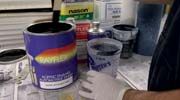
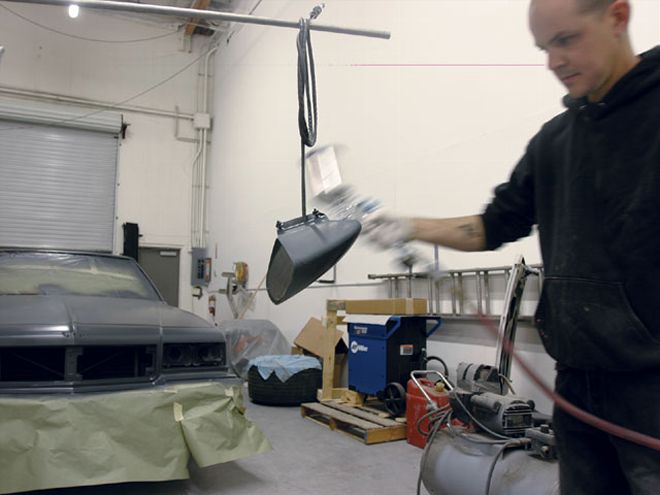 You should always wear a respirator when you are painting.
You should always wear a respirator when you are painting.
It's cool to paint your own car, but talking to the guy at the paint store may cause you to reconsider your plan. Enamel? Urethane? Two-part? Single-stage? The terminology alone can send many people right back out the door. We'll help you sort through some of the confusion with a parts-store cheat sheet, share some of our knowledge based on personal experience, talk to a couple of pro painters, and illustrate some of the latest trendy ideas that even the novice can pull off.
The Basics
All paints are made up of three ingredients: binder, pigment, and a carrier agent. Pigment, or tint, is self-explanatory-it's the color you see. Binder is often referred to as resin, and it can be helpful to think of it like tree sap, that thick, sticky hydrocarbon liquid that hardens when exposed to air. And carrier agent refers to the solution that the resin is suspended in. It keeps the binder in liquid form until it is applied, at which time it either evaporates or chemically bonds to the surface of the car.
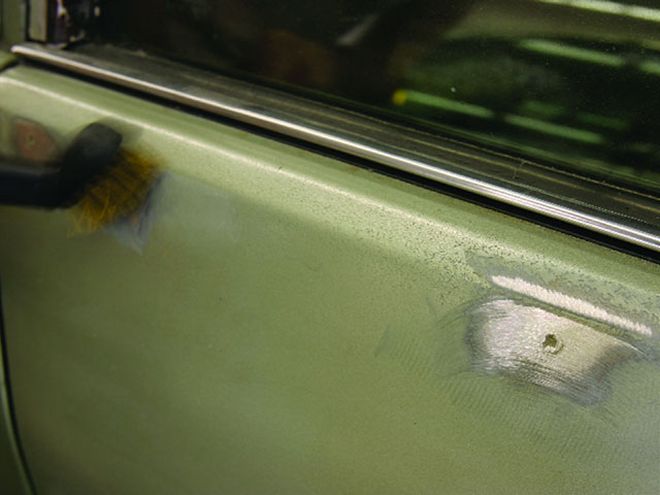 Did you know that GM was still painting its cars with lacquer into the late '80s? This '86 Caprice was sporting its OE Seafoam Green lacquer. Look at how badly the paint is cracked along the top of the doorsill. The whole car needed to be stripped to bare metal.
Did you know that GM was still painting its cars with lacquer into the late '80s? This '86 Caprice was sporting its OE Seafoam Green lacquer. Look at how badly the paint is cracked along the top of the doorsill. The whole car needed to be stripped to bare metal.
Automotive paint resins are usually one of the following three chemical compounds: lacquer, enamel, or urethane. Lacquer is difficult to find (and illegal to spray) in pollution-controlled areas of the country, but it's worth mentioning because you'll still hear guys waxing poetic about hand-rubbed lacquer. The appeal of lacquer is that it's easy to spray, and it dries to a smooth, glossy show-car finish. Compared to today's paints, though, lacquer is crap because it needs a lot of maintenance in the form of waxing and buffing, and it becomes brittle with age. Exposure to sunlight accelerates its aging, and if not religiously maintained, lacquer will be cracked and chalky in a few years. It's also the gross polluter of the paint world because lacquer cures by drying rather than chemically bonding to the car. In other words, the liquid portions of the paint evaporate, leaving the tinted resin, or color coat, behind. Those liquid portions are highly toxic solvents like toluene that don't react well with Green Party members. So lacquer is great for a show car that spends 90 percent of its life in a climate-controlled garage, but not practical on a driver.
That leaves enamels and urethanes as the remaining options. To confound novice painters, there are many varieties of these resins. There are synthetic, acrylic, and even hybrids of the two (urethane enamel, for example). But in general, urethane and enamel refer to the chemistry of the hydrocarbon polymers that form the resin of the paint. And that chemistry affects the look and durability of the finish, how it is sprayed on the car, and, of course, how much it costs.
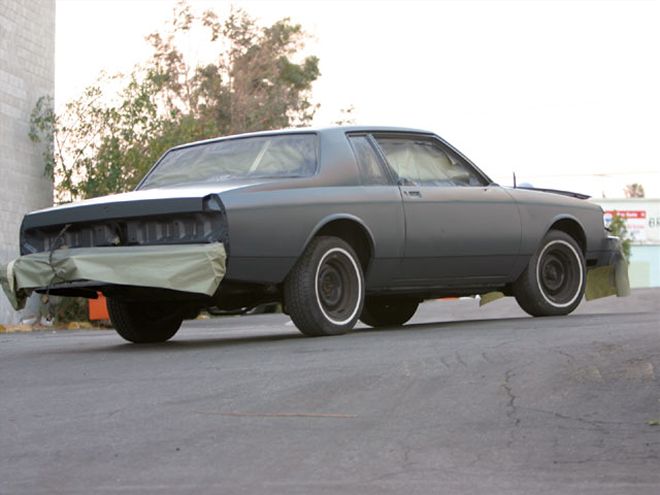 The best paint in the world is guaranteed to look bad on a car that wasn't prepped correctly. We used a quality primer-sealer and wiped the car thoroughly with wax and grease remover and a tack cloth first before spraying any color.
The best paint in the world is guaranteed to look bad on a car that wasn't prepped correctly. We used a quality primer-sealer and wiped the car thoroughly with wax and grease remover and a tack cloth first before spraying any color.
Seeking clarity, we spoke to some industry insiders about the differences between these two compounds, and all were in agreement: Enamels are a softer resin, usually dry to a glossy finish, and are less expensive than urethanes. Urethanes are generally a more durable product but can be more difficult to spray. Most new cars are painted with a type of urethane, and most collision repair shops use urethane to repair damage. Maaco, Earl Scheib, and 1-Day Paint often use enamels for their economy.
Single-stage, Two-component
Once you've chosen the type of paint you'll be spraying, you may have a couple more options: One- or two-part? Single-stage or basecoat/ clearcoat?
One- or two-part (or -component) is also referred to as 1K or 2K, and it simply means that the paint either does or does not require an activator to dry. One-part products are ready to spray-they may need to be diluted with a solvent, sometimes referred to as a reducer or thinner, to flow through the spray gun properly, but they will dry on their own. Usually one-part paints are not used to repaint an entire car. Nearly all aerosol-can paints are one-part, as are One Shot pinstriping enamels and specialty products like Eastwood's Chassis Black.
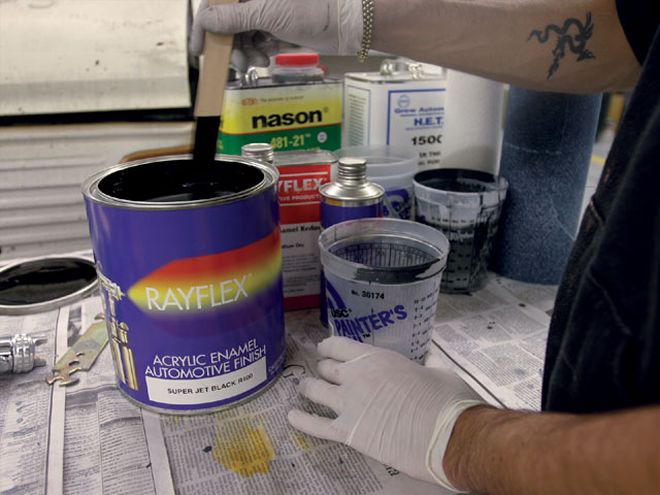 For the guy on a real tight budget, we came across a gallon of automotive paint for $35 at paintforcars.com. Incredulous, we placed an order. The sales rep we spoke to said this paint was on a par with the type of product Maaco would spray for its budget job. It's a two-component, single-stage acrylic enamel. Acrylic enamel (as opposed to synthetic enamel) refers to an acrylic polymer, or plastic, that is mixed with the enamel resin. The red can behind the paint is reducer, or thinner. You'll see why that's important soon.
For the guy on a real tight budget, we came across a gallon of automotive paint for $35 at paintforcars.com. Incredulous, we placed an order. The sales rep we spoke to said this paint was on a par with the type of product Maaco would spray for its budget job. It's a two-component, single-stage acrylic enamel. Acrylic enamel (as opposed to synthetic enamel) refers to an acrylic polymer, or plastic, that is mixed with the enamel resin. The red can behind the paint is reducer, or thinner. You'll see why that's important soon.
Two-part products need an activator, sometimes referred to as a hardener, to stimulate the chemical reaction that causes the components of the paint to cross-link and bond to the surface of the car. We refer to this chemical reaction as "drying," though it really is not drying in the sense of evaporating. Unactivated two-part paint will not dry on its own and therefore has a longer shelf life than one-part paint. For the suede and kustom guys, it's worth noting that two-part products are weatherproof and nonporous. You can leave your car in a 2K primer and not worry about the sheetmetal rusting from the inside out.
Single-stage paint dries to a glossy finish and does not need a clearcoat, whereas the basecoat, or color coat, of a basecoat/clearcoat (BC/CC) system dries to a matte or semigloss finish. The subsequent coats of clear paint are what make it shine. Which one is better? In terms of quality, both are good; it just depends on what color you want. If you want a basic red, black, yellow, or whatever, you can save yourself some time and money by using a single-stage paint-you will not need to clearcoat it. If you want a metallic finish, there are some available in single-stage, but you may be better off with a BC/CC system. The extra layer of clear is added protection against scratches and chips, and it allows for more wet-sanding for an ultrasmooth gloss. If you're thinking about something wilder like a metalflake or pearl, you must use a BC/CC system because the metalflake and pearl treatments are sprayed in between the color and clearcoat.
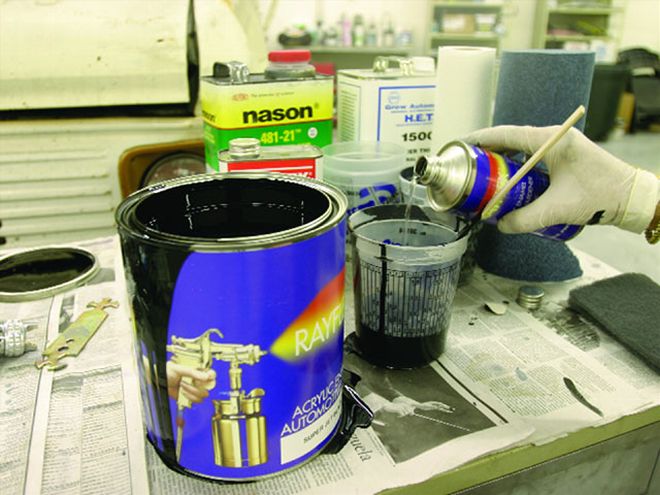 Since this is a two-part paint, it needs to be activated. In this case, the mix ratio is 4:1-four parts paint to one part activator (called hardener on the label).
Since this is a two-part paint, it needs to be activated. In this case, the mix ratio is 4:1-four parts paint to one part activator (called hardener on the label).
So those are the basics to arm yourself with before going to the paint store. If you are still up for painting your car, Brian Ferre, a painter for over 30 years and an instructor at Los Angeles Trade Technical College (LATTC), says today's paints are the best they have ever been. He recommends that you pick a brand and use its products throughout the entire paint job. That way each layer, from etching primer to topcoat, will be compatible. Chemistry can vary from brand to brand, and mixing products can sometimes cause strange things to happen to the finish. You don't want to have to sand off your newly clearcoated car because the basecoat started lifting off the primer. For a step-by-step of a recent paint job we did, check out the April '07 issue, in which we gave the CC/Rambler a BC/CC paint job. For our experiments we decided to check out some of the less expensive single-stage paints, as well as a water-based paint from Auto-Air Colors.
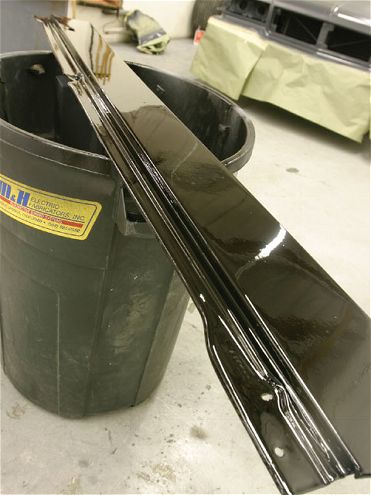 Properly thinned, this actually started to look like a decent finish, and the paint flowed out even more as it dried, getting rid of most of the orange peel. Spraying this paint took some getting used to; it had to be thinned to almost the consistency of water, and it needed to be sprayed on much thicker than the urethanes we'd used in the past. It dried a lot more slowly, too.
Properly thinned, this actually started to look like a decent finish, and the paint flowed out even more as it dried, getting rid of most of the orange peel. Spraying this paint took some getting used to; it had to be thinned to almost the consistency of water, and it needed to be sprayed on much thicker than the urethanes we'd used in the past. It dried a lot more slowly, too.
Waterborne And Water-Based Paint
California is in the process of further lowering the amount of air pollution emitted by automotive paints, and its guidelines are usually adopted by many other areas of the country within a few years. Even though modern paints don't dry by evaporation, some chemicals called volatile organic compounds (V0Cs) are released when the paint is atomized at the tip of the spray gun and as the paint cures. These VOCs are what allegedly put holes in the ozone layer, rot your brain, and cause confusion, poor math scores, plagues, famines, and other natural disasters. Actually, most of the ingredients in paint are poisonous, and some of the solvents are things like isocyanates-chemicals closely related to cyanide that were used to execute people in the gas chamber-so it is worth looking into eliminating some of these byproducts.
Waterborne paints are the generally accepted solution to that problem. While they're still solvent-based, meaning the carrier agents are petroleum products, the carrier and binder will mix with water, and water is in fact one of the ingredients of the carrier agents in these paints that evaporates as part of the paint-curing process. Waterborne paints have been the industry standard in Europe for several years because regulations are more stringent than in the U.S. There's no need to fear waterborne paints-when was the last time you saw bad paint on a new BMW? All of the major brands available in the U.S., such as PPG, DuPont, and Sherwin-Williams, will be bringing their versions of waterborne paints to market soon.
While the big guys scramble to get their waterborne paints out, there is a small company in Connecticut that has been making completely water-based automotive paint for almost 30 years. Auto-Air Colors started in 1978, marketing its products to custom painters and airbrush artists. Craig Kennedy now runs the company begun by his parents, and we spoke to him about its paint. "Basically, it starts out as a giant blob of plastic," he says, referring to the acrylic polymer that forms the resin for Auto-Air's products. "We then add things to it to keep it in a liquid state." The majority of Auto-Air's carrier agent is water, which separates it from other waterborne paints. Auto-Air has no solvents and emits no VOCs as it dries. "You could drink it if you want to, though we don't recommend it," Kennedy says. He happily sent us a quart of basic black to try out, which we took to Ferre at LATTC so he could show us how to use it.
Since no one makes a water-based clearcoat, you'll have to spray a solvent-based clear over an Auto-Air basecoat. The company offers a wide variety of colors and a lot of cool custom options, from candies and pearls to metalflake and fluorescent colors. Kennedy says the trends he's seeing now are subtle two-tone paint jobs and pearl accents being used on body lines. "Real fire is dead," he says. "We're seeing a lot more toned-down paint jobs, and the two-tone is coming back." Judging by the ease with which our basic black went on, we may just try out a custom paint job of our own. Stay tuned for the outcome.